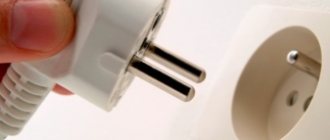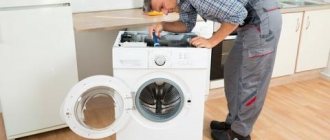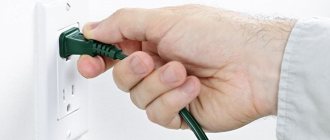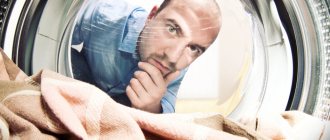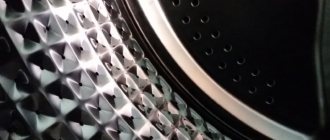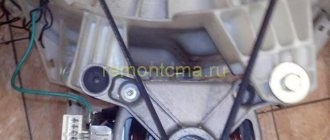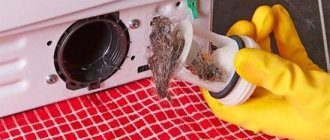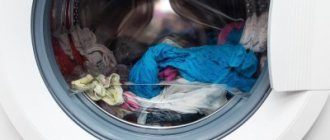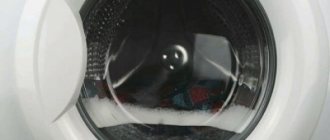Even such high-quality washing machines as Bosh can stop working and the reason for this can be a very large number of different problems, ranging from a broken socket to direct breakdowns inside the washing machine motor and so on. If a breakdown occurs, we do not recommend trying to repair the machine yourself; it is better to contact a service center for repairs.
Bosch washing machine won't spin?
You should not panic, but rather calm down and perform the simplest actions that will help you take a more sober look at the current situation. First, you need to unplug the machine cord from the washing socket, and then drain the water using a drain filter. It's very easy to find. It is located at the bottom of the front panel of the machine. Afterwards, you need to take out all the laundry and try to visually understand at what point the drum stopped rotating?
The drum stopped spinning during the spin cycle
If the laundry is no longer soapy, but still remains quite damp, then the problem is most likely with the spin cycle. We will discuss what to do in this situation a little later.
Drum jammed during washing
If things remain not just damp, but also soapy, then the drum stops working already at the washing stage. You can even check its performance with your hand. If the drum cannot be moved manually, it means it is jammed. We will also discuss what to do in this situation a little later.
Prepare thoroughly first
Disassembling the washing machine will go smoothly and without surprises if you act consistently and prepare for the procedure in advance. Preparation includes several activities at once. First of all, you need to find a place suitable for repairs - at least 4 sq.m., well lit and ventilated. For example, a garage, workshop or corridor. Be sure to arrange the room, cover the floor with oilcloth and a rag, since the work ahead will be dirty and wet.
In addition to preparing the site, you must:
- read the instructions for the machine, as well as the attached electrical diagram;
- collect the required tools and materials;
- prepare the washing machine for disassembly;
- remember safety precautions.
Before disassembling the washing machine, you must study the factory instructions and other accompanying documentation.
After studying the instructions, you can assemble the tools. The first one on the list is a screwdriver; in its absence, a Phillips and flat-head screwdriver. Next, we find a set of wrenches, a hammer, a figure-eight wrench, pliers, a multimeter, a wrench, a chisel or a recess. A felt-tip pen, WD-40 cleaner, sealant and silicone grease will also come in handy. To drain the water from the machine, you will need a rag and a suitable container.
To facilitate reassembly, it is recommended to film the disassembly process with a photo or video camera. This makes it easier to track your actions and return all the spare parts to their designated places. Particular attention must be paid to the wiring, since reconnection must be carried out strictly at the specified terminals and positions.
Main machine malfunctions
No water heating
If the machine stops heating the water completely, the automation will report this with a corresponding error. But it is possible that the heating is insufficient or slow. This can be understood by the increased running time of programs (especially if washed at high temperatures). The reasons may be as follows:
- Damage to the temperature sensor (thermostat)
The sensor looks like a silver cylinder. It is inserted from the outside into the hole of the heating element. There is wiring from the sensor to the control board. If the wiring is intact, the sensor cannot be repaired and must be replaced.
A heating element is a metal coil with an electrical conductor and a fuse inside. It is inserted into the working cavity of the washing machine under the drum, where it heats the water. From the outside, voltage and grounding from the control unit are connected to its terminals.
Failure is associated either with a burnout of the electrical circuit (fuse tripping), or with scale on the coil due to lime deposits. If the circuit of the coil itself is intact, then you can clean the working part of the heater with citric acid or special descaling agents. Otherwise, it is necessary to replace the heating element, which is not very difficult.
- Control module failure
If the “brain” of the washing machine fails, the heating command (voltage) is not sent to the heating element, and the malfunction may manifest itself intermittently and unpredictably. In this case, only flashing or replacing the board can help.
Extraneous noise during washing
First, you should make sure that the extraneous sounds are not coming from metal/plastic parts of the clothes being washed. Run “soft” clothes or a short cycle without clothes at all. If the sounds are not lost, the options are below.
- Foreign object between tank and drum
Having slipped through the holes of the drum, small buttons, bones from women's underwear, etc. hit it when washing. Disassembly required.
- Bearing failure
Bearings and seals on the drum and motor shafts are subject to serious loads, and their natural wear is faster the more intensively the machine is used. If you hear a characteristic metallic grinding noise during the washing and spinning process, this is most likely the problem. Replacing bearings is one of the most difficult repair procedures.
The machine may creak and hum during spin cycles due to wear and excessive stretching of the shock absorbers - the metal springs on which the drum is suspended. They should be changed in pairs to avoid distortion.
- Free movement of counterweight
A counterweight is a heavy stone (concrete) pad attached to the drum from the front to absorb vibrations during spinning. If the bolts holding it in place are loose, unnecessary vibrations and loud knocking noises may occur.
Engine problems
Motors in Bosch washing machines come with direct drive and commutator drive. The latter are equipped with carbon brushes, which create an electromagnetic field in the motor rotor when friction against its walls. Worn bristles make it impossible to start the engine. They need to be replaced.
Other problems may be related to electrical issues: power surges in the network, interturn short circuits in the motor windings, etc. Such malfunctions are usually fixed at a service center.
The drum does not spin
If the engine is working properly, but there is no rotation, you should go through the options.
Avoid any mechanical blocking of the tank rotation. A foreign body can be located both inside and outside it.
The rubber belt that transmits rotation from the motor shaft to the drum shaft can shift, break, or stretch. To check it, just remove the back cover. It can be easily changed independently, you just need to purchase a spare part strictly in accordance with the machine article number.
- Control unit malfunction
Failure of the control module is diagnosed by excluding other causes and by starting from an “external” known-good board. As a rule, it can only be repaired in workshops.
Water does not drain
- Mechanical problem
The drain hose may be pinched or kinked. It is also worth unscrewing and checking the filter of the washing machine, located in its base. If it is also clean, you can try disconnecting the drain hose from the point of entry into the sewer and running a program to drain into a bathtub, sink or large container. This will prevent clogging of the siphon (if any) or sewer pipes.
- Broken water level sensor
If the sensor is broken, the control board may stop the drain pump prematurely or not start it at all.
A pump (or drain pump) is a small motor with a plastic impeller that pumps water into the drain system.
A sure sign of its failure is a quiet low hum of the machine when trying to drain the water and the absence of water gurgling at the same time. The windings of the pump motor hum, but the mechanism itself does not spin. The cause is often lime deposits.
The part needs to be replaced.
Incorrect system operation
Unpredictable, unsystematic behavior of the washing machine usually indicates a breakdown of the control unit. Stops, long pauses in washing cycles, a strong discrepancy between the actual execution time of programs and the stated duration are sure signs of a brain breakdown. Also, the machine may simply not turn on, not spin, or open at the end of the program.
In devices with electronic control, the board must be replaced. The procedure is not complicated, but the cost of the part can reach half the price of a new machine. Electromechanical models with a programmer allow you to “reflash” it
Causes of breakdowns
The design of the Bosch washing machine determines both the nature of the breakdowns and the causes of their occurrence. Let's look at what usually causes failures.
After washing, waste water remains in the tank. This happens for the following reasons:
- Failure of the drain pump (pump).
- There is a blockage in the filter or pump.
- Pump contacts are burnt out or oxidized.
- The pressure switch is broken.
If the drum is stuck tightly, this may be due to the following reasons:
- The drive belt is damaged.
- Electronics malfunction.
- Less commonly, engine failure.
Drum noise is associated with:
- Broken bearings (the bearing in the Bosch washing machine will need to be replaced).
- Litter and foreign objects in the tank.
- Loose or broken shock absorbers.
- Torn out counterweight.
Water does not flow into the drum because:
- There is no water in the water supply system, low pressure.
- The pump or the Aqua-Stop system is clogged.
- Kink in the drain hose.
Engine failure coincides with the following “symptoms”:
- Open hatch.
- Controller failure.
Having determined what caused the malfunction and assessed its complexity, you can begin repairing Bosch washing machines yourself.
If you have not identified the breakdown and do not know how to repair the washing machine, contact a specialist.
The listed causes of breakdowns are most typical for the Bosch Classic 5, Bosch Maxx 5, Bosch Max 4, Bosch Maxx 6 models, but other models can also fail for the same reasons.
Purchase and installation
So, you have chosen this model.
You can buy a bosch classixx 5 washing machine at any major chain that sells household appliances.
After delivering the car to your home, you should immediately check it for defects, preferably together with the delivery person. Otherwise, you need to do this yourself within two weeks in order to easily return it to the seller. After this period, returns will no longer be problematic.
So, let’s say a specialist unpacked the washing machine in front of you and the unit looks great externally - without dents, scratches or other external damage.
Further, when installing, it is better to trust a professional. Pay attention to companies that provide this service for free. But be sure to check that everything is set to the correct level.
However, if you want to install the bosch classixx 5 washing machine yourself, the instructions will help you.
The main thing is to pay attention to the place for your new equipment, it should be leveled and the base of the floor should be strengthened, carpets and other soft floor coverings should be removed. In addition, it is necessary to connect all communications: water supply, sewerage and electricity.
After that, we begin to level the model strictly according to the level. It is very important.
Firstly, the machine will not bounce on the floor, and secondly, the parts will be subject to less wear and tear and your machine will last you much longer.
In the store, when purchasing a washing machine, you will additionally be offered to buy anti-vibration footrests. With them the car will work much quieter.
Diagnostics of Bosch breakdowns
Diagnostics of a Bosch washing machine is a built-in function in all modern machines. Thanks to it, you can determine the essence of the breakdown without calling the workshop. If you did not find in the instructions a step-by-step description of how to carry out the diagnosis yourself, we will describe in detail how to do this:
- Close the loading hatch.
- Set the program selection wheel to o.
- Wait a couple of seconds.
- Set the selector to the “SPIN” mode.
- If you did everything correctly, the “START” light will blink.
- Press the "SPIN RPM" button and do not remove your finger until the "START" indicator flashes again.
- Turn the wheel again, this time stopping it at the DRAIN program.
Attention! Rotate the selector only to the right.
- After releasing the SPIN RPM button, select the item you want to test by turning the wheel. Or determine the breakdown by the error code displayed on the display.
Important! If the diagnostics do not start, then the problem is in the control board (electronic controller), and in this case you cannot do without calling a technician.
If you decide to manually check individual parts, turn the selector wheel to select the desired item. Proceed this way:
- Engine check: position 3.
- 4 - for testing the pump.
- 5 - check the heating element.
- 6 - hot water intake valve.
- 7 - cold water intake valve.
- 8 — water intake valve for the main wash.
- 9 — pre-wash water intake valve.
- 10 - sound signals.
- 11 - FCW autotest.
- 14-15 - “quick” autotest.
Next, press “START” again (in addition to this indicator, “DRAIN” and “SPIN” are also lit) to start the program test.
To exit the program test mode, press “START” and turn the wheel.
To exit the diagnostic mode, turn the wheel to o or “OFF”.
